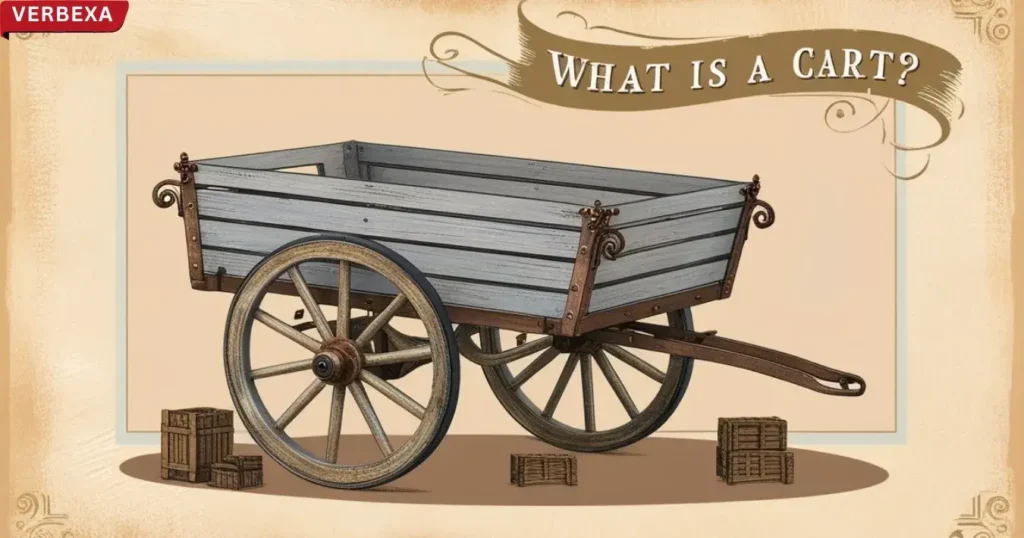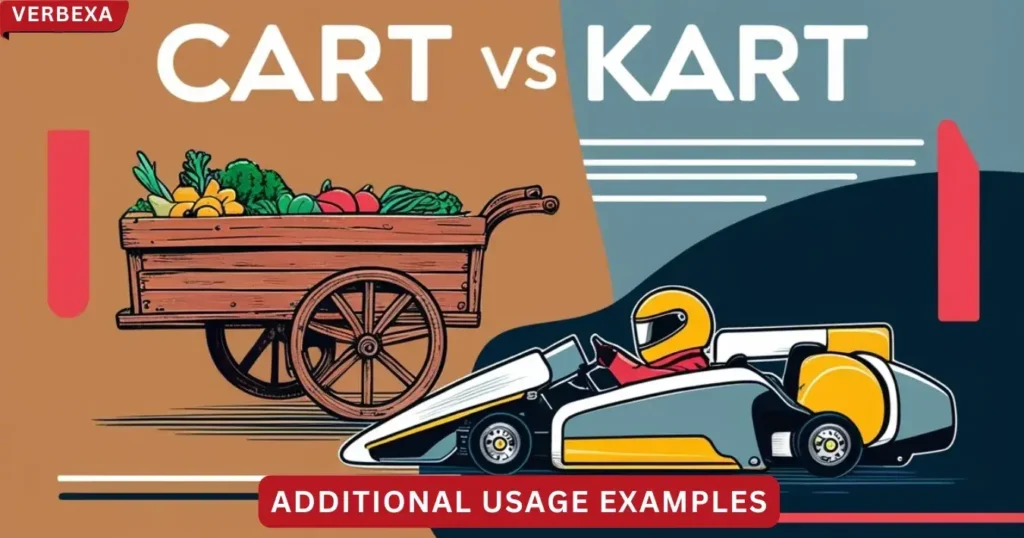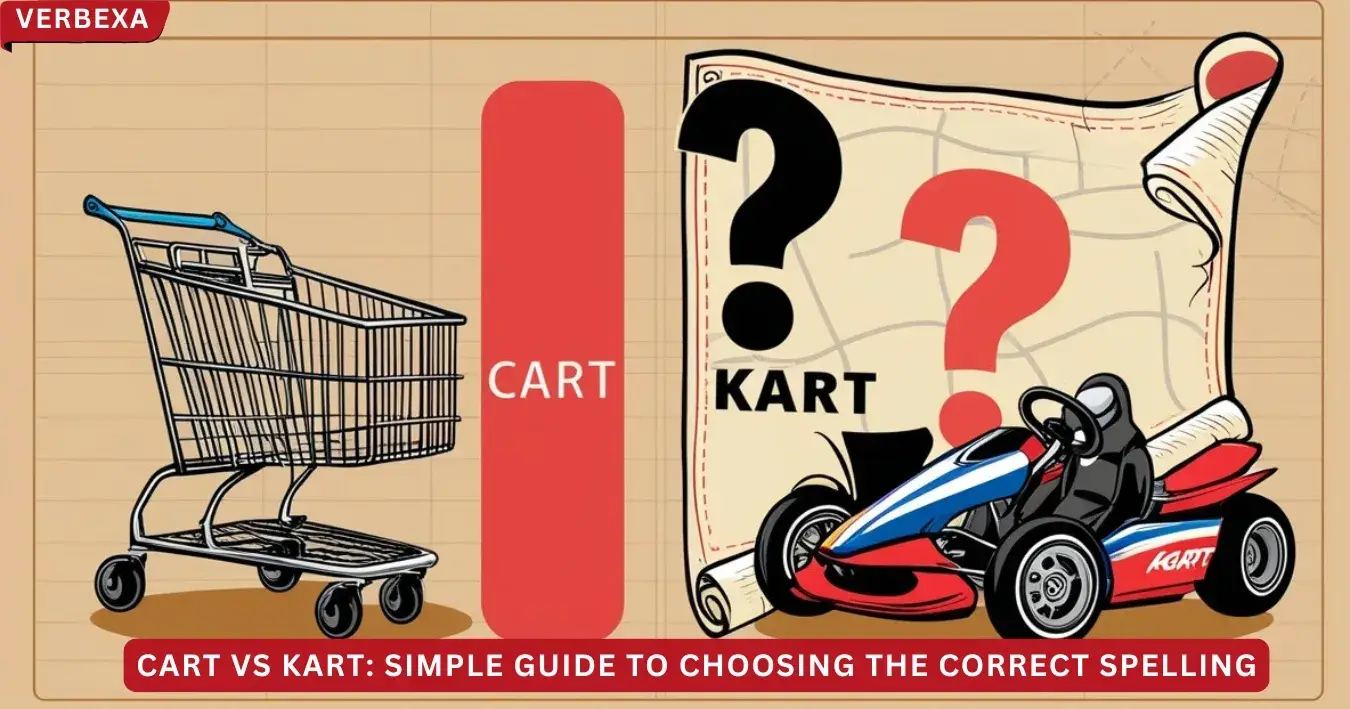Language can be confusing, especially when two terms sound alike but have different meanings. One of the most commonly misused pairs is Cart vs Kart. While these words are easy to mix up due to their similar pronunciation, understanding the difference between them is important for effective communication. This article will delve into the distinctions, helping you confidently choose the right word in different situations.
If you’ve ever found yourself wondering, “Cart or Kart?” or asked, “How do you spell Cart?” you’re not alone. Whether you’re shopping online, racing at the track, or talking about vehicles, this guide will clarify how to use Cart vs Kart correctly.
What’s the Difference Between Cart and Kart?
Before diving into the specifics of cart vs kart, it’s important to understand the basic definitions of both words:
- Cart refers to a wheeled vehicle used to carry goods or people, often manually pushed or pulled. These vehicles come in many forms, including shopping carts, horse-drawn carts, and hand carts used in agriculture.
- Kart, on the other hand, refers to a small, usually motorized vehicle designed for racing or recreational purposes. Karts are typically lightweight and used for speed, often on specialized tracks.
Although they sound similar, cart vs kart is a distinction that’s crucial for clear communication. Let’s explore their meanings in more detail.
Definitions and Usage of Cart and Kart
What Is a Cart?

A cart is a general term for any wheeled vehicle designed for the transportation of goods or passengers. It is often associated with older or simpler forms of transport. Carts are used in various industries, including agriculture, e-commerce, and shopping.
Types of Carts:
| Type of Cart | Purpose | Example Uses |
|---|---|---|
| Shopping Cart | Carry groceries and items in stores or online | Grocery store, e-commerce shopping cart |
| Hand Cart | Move heavy goods manually | Warehouses, construction sites, hand cart usage |
| Horse-drawn Cart | Animal-powered transport for goods | Farms, rural areas, horse-drawn carriage transport |
| Golf Cart | Transport people and equipment on golf courses | Golf courses, country clubs, recreational transport |
| Food Cart | Mobile food vendor vehicle | Street vendors, food markets, food cart at events |
| Online Shopping Cart | Digital storage of items for checkout | Websites, mobile apps |
In these cases, cart refers to anything designed to carry items—whether on wheels or animal-powered—without being motorized or built for speed.
What Is a Kart?
On the other hand, a kart refers to a small, often motorized vehicle that is typically used for racing or recreational purposes. Karts are low to the ground and lightweight, designed for speed. They are commonly seen in competitive racing events, go-karting tracks, or even in video games.
Types of Karts:
- Go-Kart: A small, motorized vehicle designed for racing, typically seen in competitive kart racing or recreational settings.
- Racing Kart: A high-performance, professional version of a go-kart used in serious racing competitions.
- Karting: A motorsport that involves racing with go-karts, typically held on specialized tracks.
| Type of Kart | Purpose | Example Uses |
|---|---|---|
| Go-Kart | Lightweight, motorized vehicle designed for racing | Kart racing tracks, recreational racing, competitive go-karting events |
| Racing Kart | High-performance kart used in professional racing | Kart racing events, professional karting competitions |
| Karting | Sport involving racing with karts | Karting tracks, recreational karting, competitive kart racing events |
Kart is specifically associated with speed and racing, unlike cart, which is used for general transportation.
Kart vs Cart: Understanding Their Differences
The most crucial distinction between Cart vs Kart lies in their purpose and design. Let’s break this down with a simple comparison:
| Aspect | Cart | Kart |
|---|---|---|
| Definition | A vehicle designed for transporting goods or people. | A small, often motorized vehicle designed for speed and racing. |
| Usage | Agriculture, shopping, logistics, or manual transportation. | Competitive racing or recreational purposes, like go-karting. |
| Power Source | Manual or animal-powered (e.g., horse-drawn). | Typically motorized (e.g., gas or electric engines). |
| Speed | Generally slow and practical. | Fast and designed for speed. |
| Common Contexts | Shopping cart, food cart, golf cart. | Go-kart, racing kart, karting events. |
As you can see, the kart is specialized for racing and speed, whereas the cart is used for everyday transportation of goods or people, often with no motor or a low-speed design.
Synonyms for Cart and Kart
To help clarify even further, here are the synonyms for both cart vs kart:
Synonyms for Cart:
- Trolley
- Wagon
- Carriage
- Wheelbarrow
- Dolly
- Barrow
- Buggy
- Handcart
- Pushcart
- Pallet
Kart Synonyms:
- Go-Kart
- Racing vehicle
- Speedster
- Mini-car
- Track car
- Mini racer
- Motorized cart
- Dune buggy
- Sports kart
- Track racer
Origins of “Cart” and “Kart”
The Origins of “Cart”
The word cart has ancient roots and has evolved over centuries to describe a wide variety of wheeled vehicles designed for transportation. Its journey through history reflects changes in human societies, from agricultural use to modern-day logistics.
Etymology of “Cart”
The term cart comes from the Old Norse word “karr”, which means a two-wheeled vehicle or wagon. It is related to the Old English “ceart”, also meaning a cart or a wagon. The use of carts dates back to ancient civilizations, where they were essential tools for transporting goods, materials, and even people. They were often drawn by animals, such as horses or oxen, and played a pivotal role in agriculture and trade.
Historical Use of “Cart”
Carts have been used throughout history in various forms, from horse-drawn carts in medieval Europe to hand carts used by laborers in modern times. In agriculture, carts were indispensable for moving crops from fields to storage areas. As human society progressed, the function of carts expanded beyond farming to include their use in transportation, logistics, and shopping.
- Agricultural Carts: In ancient farming cultures, carts were used to transport harvested crops and tools.
- Trade and Transport: Carts allowed goods to be moved over long distances, facilitating trade across regions and even countries.
- Shopping Carts: In the 20th century, with the advent of supermarkets, the modern shopping cart was created to help customers collect goods while shopping.
Over time, the word cart expanded to cover a variety of forms, including digital ones like the shopping cart in e-commerce, which is used to collect products for purchase online.
The Origins of “Kart”
The word kart is relatively modern compared to cart, and its origins are closely tied to the development of motorsports and the rise of go-karting as a popular recreational activity.
Etymology of “Kart”
The word kart is believed to be a shortened version of the word “go-kart”, which is a compound term describing small, motorized vehicles designed for racing. The first go-karts appeared in the United States in the late 1950s. The word “kart” itself likely evolved from the idea of a small cart or a miniature vehicle, but with the addition of an engine, transforming it from a simple transport vehicle into a high-speed racing machine.
The Birth of Go-Karting
The rise of go-karting can be traced back to 1956 when an American named Art Ingels built the first go-kart in Southern California. Ingels, a former engineer for the famous car manufacturer Ford, built the first go-kart with a lawnmower engine and simple, lightweight materials. He used it for fun at local races, and the sport quickly gained popularity. The term “go-kart” became synonymous with this new form of motorsport.
By the 1960s, go-kart racing had become a global phenomenon, and the word kart was increasingly used to describe the vehicles used in these races. The kart was characterized by its compact size, lightweight design, and powerful engine, which made it ideal for high-speed racing.
Modern Use of “Kart”
Today, karting has become a professional sport, with various competitive leagues, including the International Karting Federation and World Karting Association. The go-kart has also evolved, with various types of karts used for recreational racing and professional events.
The kart has also made its way into popular culture, especially with video games such as Mario Kart, which helped popularize the sport and the word itself in a different context.
When to Use Each Term: Practical Guidelines
So when should you use cart and when should you use kart? Here are some scenarios that will help you choose the correct term:
When to Use Cart:
- Shopping Cart: This is the most common usage in everyday life. Whether you’re at the store or on an online shopping platform, the shopping cart is what you use to hold your selected items before checkout.
- Example: “I added some fruits to my shopping cart before proceeding to checkout.”
- Golf Cart: When referring to the small vehicles used to transport golfers on a course, the term golf cart is used.
- Example: “We rented a golf cart to get around the golf course.”
- Food Cart: Street vendors often use food carts to sell their goods. These are mobile, compact stalls for selling food.
- Example: “The food cart on the corner sells the best tacos.”
- Hand Cart: Used to carry goods manually. Often found in agricultural settings or small-scale logistics.
- Example: “I need a hand cart to move these boxes to the storage area.”
When to Use Kart:
- Go-Kart: If you’re talking about a small, motorized vehicle used for racing, then go-kart is the correct term.
- Example: “I spent the afternoon racing go-karts with my friends.”
- Racing Kart: This is a professional version of a go-kart, used in competitive racing events.
- Example: “He trained hard to compete in kart racing events.”
- Karting: When referring to the sport or activity of racing karts, the term karting is used.
- Example: “She’s been karting since she was ten and dreams of becoming a professional racer.”
Cart vs Kart in the Context of Motorsports
One of the most confusing aspects of the cart vs kart debate happens in the context of motorsports. Many people, especially newcomers to the sport, get confused between karting and other forms of racing.
When people talk about Cart vs Kart vs Go Kart, they might be referring to the same thing but with different levels of competition or types of racing. Here’s the breakdown:
- Karting: The sport of racing with karts, often on short, oval tracks or in specialized circuits.
- Go Kart: A common term for small karts, often used in recreational or amateur racing.
- Kart Racing: The competitive aspect of karting, usually involving professional racing karts.
Understanding karting meaning and the differences between go kart, kart, and kart racing is essential for anyone interested in the sport.
Additional Usage Examples

To further understand the difference between cart vs kart, let’s look at a few more everyday examples:
- Shopping Cart: “I forgot to pick up milk, so I had to go back and add it to my shopping cart.”
- Go Kart: “We’re heading to the go-kart track this weekend for some fun.”
- CART Drug: In the medical world, CART refers to Chimeric Antigen Receptor T-cell therapy, a type of immunotherapy used in cancer treatment.
- Example: “The patient is undergoing CART drug therapy as part of their treatment plan.”
- Food Cart: “The food cart outside the building serves amazing sandwiches.”
Common Mistakes and How to Avoid Them
When using cart and kart, one common mistake is confusing the two due to their similar spelling and pronunciation. To avoid this, remember that cart refers to a vehicle for transporting goods or people, while kart is a small, often motorized vehicle used in racing. Additionally, ensure the context aligns—shopping cart for stores and go-kart for racing. Paying attention to the setting will help you choose the right term every time.
The Future of Cart and Kart
As technology advances, the future of cart and kart will see further innovations. Carts may become more automated, with autonomous shopping carts and golf carts enhancing convenience in everyday tasks. Meanwhile, karts will likely continue evolving with electric engines, making karting more sustainable and accessible. The growing popularity of e-commerce and motorsports ensures that both terms will remain integral to their respective industries.
Conclusion: Mastering Cart vs Kart
By now, you should clearly understand the differences between cart vs kart. While both words sound similar, their meanings and uses are distinct. A cart refers to a vehicle for transporting goods or people, typically without a motor or designed for slow transport. On the other hand, a kart refers to a small, motorized vehicle designed for racing or recreation.
Quick Summary:
- Cart: Use for transporting goods or people, like a shopping cart, golf cart, or food cart.
- Kart: Use for small, motorized vehicles used in kart racing, like go-karts.
Next time you ask, “Kart vs Cart?”, you’ll know exactly which term to use based on the context. Whether you’re shopping online, racing at the track, or learning about new treatments like CART drug therapy, this guide will help you make the correct choice.

This author is a passionate linguist and grammar enthusiast, dedicated to helping individuals master the art of language. With years of experience in teaching and editing, she brings clarity and precision to every sentence. Tina’s mission is to empower writers of all levels to express themselves with confidence and excellence.

